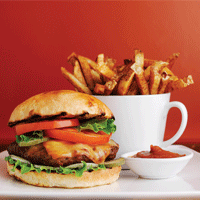Chefs and consumers flip for gourmet, super-premium hamburgers
Back in the day, when Magnum P.I. ruled the airwaves, men wore short shorts and drank O.V., and women aspired to that perfectly feathered Christy Brinkley ’do — or 1983, to be exact — every town in Canada had a beloved burger joint. And there was no debate as to its lofty status. This mom-and-pop shop usually had such a long history of serving great burgers and fries it became ingrained in the fabric of the community.
Sometimes that popularity made it emblematic of an entire region. The proprietors of Weber’s, a roadside burger stand in Muskoka, Ont., had to build a bridge across Highway 11 so southbound travellers could get their fix before heading home from cottage country. Scores of Weber’s junkies were so borderline obsessive about their burgers they would illegally cross the busy highway on foot — drunk with the anticipation of juicy, umami-laden, flame-broiled beef — giving new meaning to the phrase, “I’d die for a burger right now.”
Today, you’d be hard-pressed to pinpoint the best burger in any one town, because most have a wealth of exceptional options to choose from. The mom-and-pop outlets are still doing well, but QSR chains have added premium burgers to their menus en masse. Family casual restaurants boast better patties, too, and upscale burger joints are opening everywhere.
At Grindhouse on King St. W. in downtown Toronto, Tim Pettigrew and his brother Rob, along with partner Mark Matusiak, are part of a growing brood of boutique burger bar operators. “My brother and I have chef’s backgrounds,” says Pettigrew, of their 20-plus years in the industry, spent mostly in fine-dining. But when they opened their own concept last December, they opted for a more casual approach. “We wanted to do a gastropub/burger bar, but make it five-star quality,” Pettigrew says.
They focused on making great hamburgers, using high-quality local ingredients. Their antibiotic- and hormone-free, grass-fed beef comes from just outside of Toronto. They make their own ketchup and mustard, too, and their pickles are pickled on-site. “We also cure and smoke our bacon. We have a beautiful smoker,” says Pettigrew, which is used to smoke cheeses sourced from Ontario and Quebec. The duo even bakes beer-infused buns, perfecting the practice over the course of a year.
To add a bit of smoky flavour into the burgers, Pettigrew seasons his hand-formed patties with Balanese long-pepper, paprika and a bit of smoked Salish salt. Grass-fed beef is also much leaner, which isn’t always the best formula for a burger, so Pettigrew cuts it with a bit of suet, creating about 30 per cent fat content on the beef.
But unlike the über-deluxe, $40 burgers Mark McEwan made famous at ByMark, Grindhouse offers great value. Plain beef burgers are just $7, tax included. “Grass-fed beef is more expensive,” says Pettigrew, noting it’s about $1 to $2 more per pound. “But we buy half-cow portions at a time and get our supplier to break it down for us.”
Why go to so much trouble to create one of the more basic items in foodservice? “We’re chefs,” says Pettigrew, “so we have a lot of fun with it. We make burgers, but we make them rock.”
They’re not alone — boutique burger bars are opening in droves across Canada. There’s Burger 55 in Penticton, B.C., Tommy Burger in Calgary and Le Gourmet Burger in Montreal to name but a few. And just in Toronto there’s Grindhouse, Craft Burger, BQM Burger Shoppe, Oh Boy Burger Market, The Burger Bar, The Gourmet Burger Co., and W Burger Bar, among many others. But while openings are currently coming fast and furious, the concept isn’t new. Ion Aimers launched The Works in Ottawa in 2001 to immediate success; today, he has eight locations and sells more than 500,000 gourmet burgers a year.
“I had the conceptual idea for The Works restaurants for about 25 years,” says Aimers, “but I waited until nine years ago to open, because I saw that people were tiring of unhealthy food. They didn’t care as much about getting it fast and paying 99 cents. I strongly believed there were areas of the marketplace willing to pay for a quality product.”
According to Aimers, there are five essential steps to making a great burger. “Without contest, fresh 100-per-cent ground beef is the most important element in a gourmet burger,” he says. The Works features two kinds of Canadian beef on its menu — regular ground chuck, which accounts for the majority of sales, and an organic product that’s steroid- and hormone-free, grain-fed and raised on a small farm. No breadcrumbs or fillers are used.
“Number 2 is that we hand-form our burgers,” Aimers continues. “It comes out of the grinder into a bag and goes right to our stores.” Next, he says, you have to cook it properly. “What you want is a red-hot rod-iron grill. The grill retains the heat of the flame and that’s what cooks the burger. It also burns the exterior of the patty a bit, which gives a fantastic flavour.” Of course, that means your staff needs to have serious skills on the grill. “You won’t find any $9-an-hour people working here,” says Aimers. “These guys are good. How you heat the ingredients, melt the cheese — it’s a process we take a lot of pride in.”
Then there’s the importance of quality of toppings. “Use non-processed, real cheese and good strips of bacon you’ve cooked or double-smoked yourself.” Finally, Aimers says you have to take risks — he’s got 65 different ingredients on the menu at The Works. The North of Fifth has fresh avocado, diced tomatoes, minced garlic and tiger shrimp ($13.47 — all burgers include a choice of a bottomless side). The Down Under features caramelized onions, a fried egg, pineapple, purple beets and gouda ($12.28) and the SK8R Boy has peanut butter, jack cheese and strip bacon ($12.29).
That’s right, peanut butter.
“It’s one of our bestsellers,” says Aimers. “The saltiness of the bacon combined with the sweetness of the peanut butter just works.”
Although you might not find peanut butter on its menus, quick-service chains like Carl’s Jr. and In and Out Burger have been offering premium hamburgers in the U.S. for years, but that idea only recently migrated north. McDonald’s launched its Angus burger in April 2008, just after A&W declared it was the first QSR in Canada to offer a sirloin burger. “Burger consumers told us through extensive market research that they wanted a premium beef burger they could enjoy quickly and conveniently on their time-pressed days,” said Mike Atkinson, director of Marketing, in a press release.
A 2009 report by Chicago-based Technomic backs up that claim. In the poll — which was taken in the midst of a crippling recession — consumers revealed that they would spend more money for premium hamburgers. Some 75 per cent ranked quality of meat as the first or second most important reason for choosing a burger, with 35 per cent claiming they would pay more for a premium offering. These findings are echoed in Canada. “Dollars for meals including premium burgers have increased by more than 15 per cent,” says Regina Ip of the NPD Group in Toronto. “The average spending per person for meals including premium burgers is $7.54, whereas meals including regular burgers average just $6.43.”
With that kind of growth, it’s no wonder Wendy’s now offers a burger with blue cheese and applewood-smoked bacon. Harvey’s recently improved its top-selling Angus burger, while South St. Burger Co. —another gourmet burger chain, serving naturally raised, 100-per-cent pure beef burgers — recently opened its 12th location, in Ajax, Ont. Burger King also just launched its Steakhouse XT premium burger, which is more than 30 per cent larger than McDonald’s Angus Third Pounders. That’s a lot of meat. In order to cook the massive patties to perfection, Burger King Corporation unveiled a secret weapon it claims will give it a competitive edge in this burgeoning burger war — a proprietary new broiler it’s calling a “game-changing piece of equipment.”
While you certainly can’t call it chic, the humble hamburger has become sexy. In some cases, they’re front and centre on fine-dining menus, featuring wild-game patties, topped with foie gras, artisanal cheese, shiitake mushrooms, shaved truffles and served with a side of Sonoma Valley Syrah.
At Canadian Rocky Mountain Resorts (CRMR), executive chef Alistair Barnes has no problem showcasing upscale burgers at any of his seven Alberta-based outlets. He’s especially fond of using game meats, which are becoming increasingly popular as Canadian cuisine continues to evolve. In fact, for the past 10 years CRMR has been humanely raising grass-fed, antibody-free buffalo, elk and caribou on its own farm just south of Calgary. Barnes takes the lesser cuts of the high-protein, low-fat meat and grinds it up for use in his 50/50 burger, which are half elk, half buffalo. He also has his own bakery, producing Tuscan-style and heavy whole wheat buns. The Game Ranch Burger sells for $16 (with a side and garnishes), and it can be topped with local artisanal cheese and double-smoked bacon.
“There’s about five or 10 per cent fat content in the meat, so we cook them medium rare to medium,” says Barnes. “We don’t want to dry these out. But the meat is so clean and pure you could eat it rare.”
And what’s a great burger without amazing fries alongside? “We use good quality, fresh potatoes,” says Barnes. “We blanche them first, in less-hot fat, which you’re really just doing for colour. Then we put them on a tray to cool down, and as we get an order we put them into some hot fat to crisp them up, seasoning them with a bit of kosher salt.”
Quality ingredients creatively put together and expertly executed — the modern burger and fry combo has everything a savvy consumer wants in a meal. “People are so much more educated about food and where it comes from,” says Pettigrew. “They’re forcing businesses to offer quality, eco-friendly products. So that’s what we do at Grindhouse. But the best part is, the guy who sits on his sofa chugging soda and eating Doritos all day doesn’t notice. To him, it’s still a big, greasy burger. I love it.”
Photographed by Margaret Mulligan




















